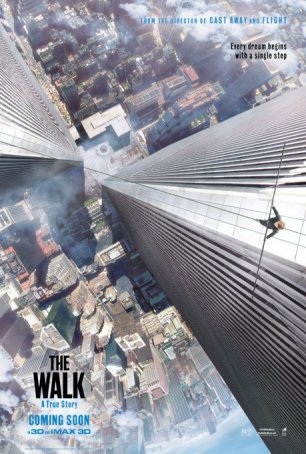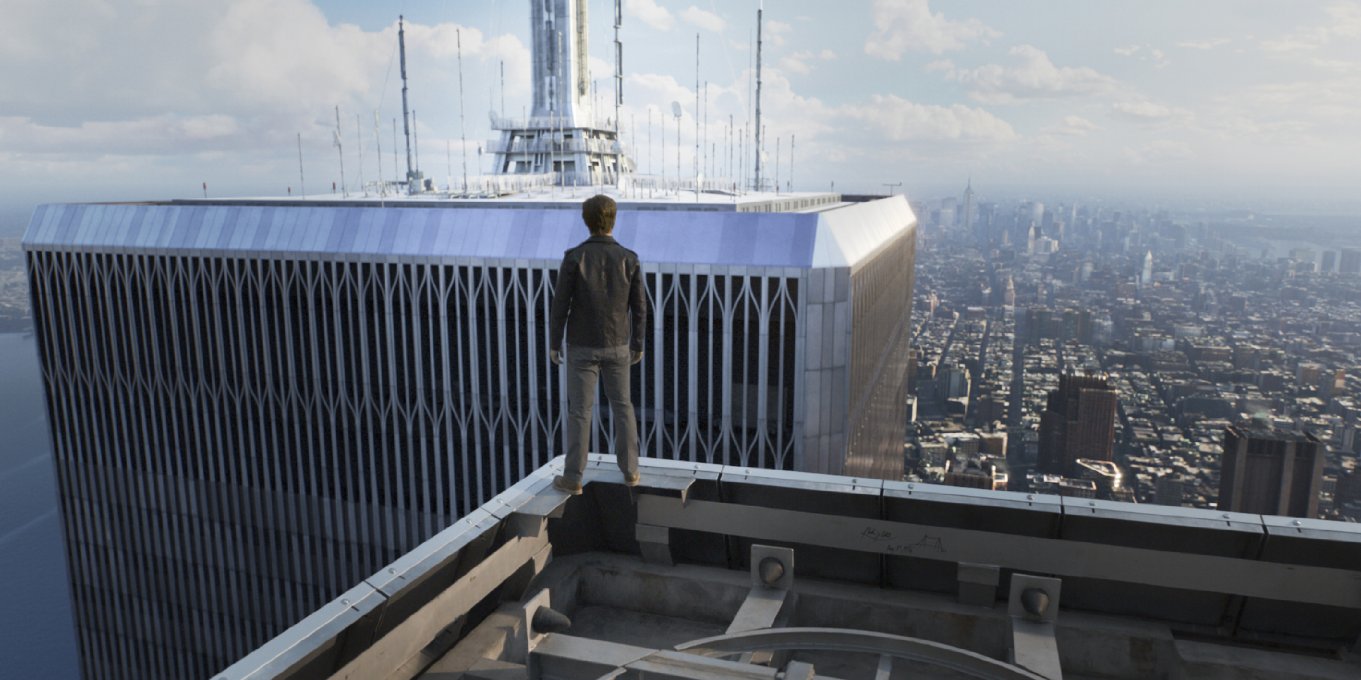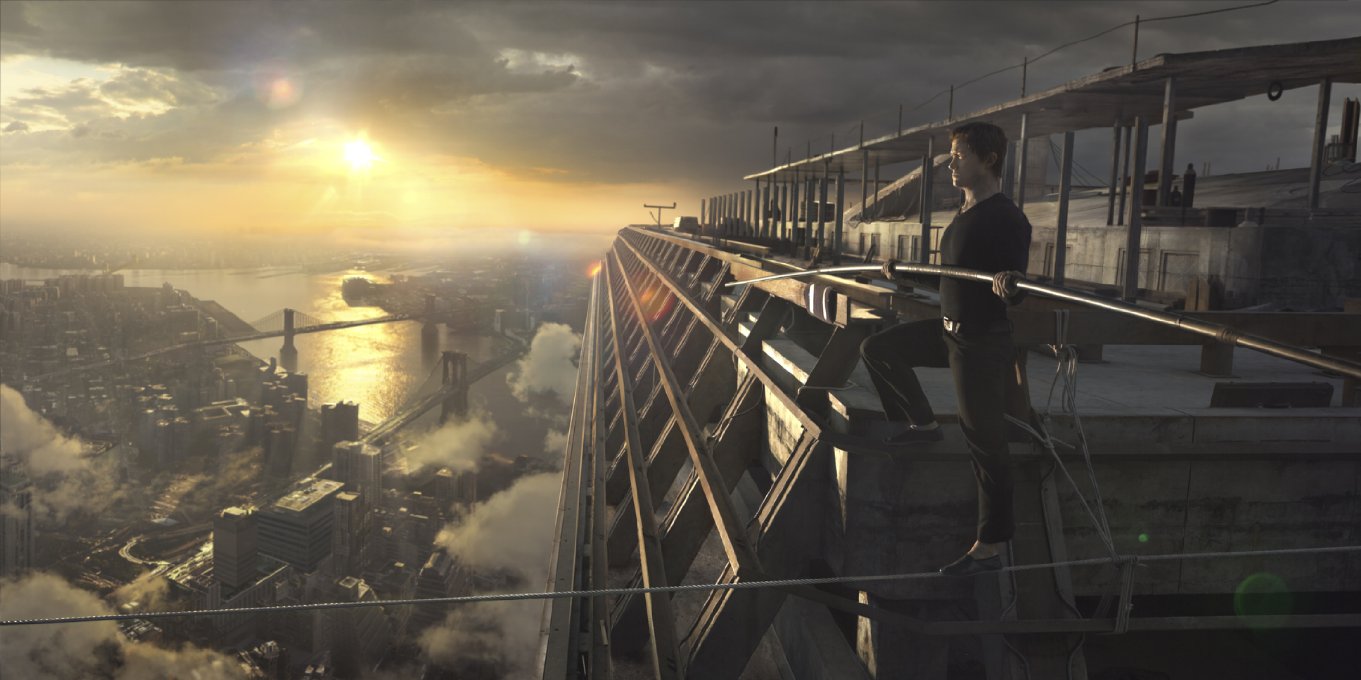Walk, The (United States, 2015)
October 04, 2015
During its short lifespan, the original World Trade Center hosted a number of strange and surreal occurrences but perhaps none was more astonishing than the tightwire walk by Frenchman Philippe Petit. The event took place during the morning of August 7, 1974 and lasted 45 minutes with Petit risking life and limb 1370 feet up to traverse a 200-foot long cable bridging the span between the Twin Towers. For this feat, Petit had no net and wore no harness. He trusted in his instincts and training and they served him well. Director Robert Zemeckis has done an impressive job of recreating Petit's walk, illustrating that the challenge was as much mental as physical and using atypical camera angles and seamless digital effects to give the audience a taste of what it was like to be on the edge of the void 41 years ago.
The Walk is divided into three clearly delineated segments. The first (and unfortunately longest) provides a biographical sketch of Philippe (Joseph Gordon-Levitt) prior to his headlining stunt. We learn a little of his background and see him meet important people like master wire walker Papa Rudy (Ben Kingsley) and Annie (Charlotte Le Bon), who would become his confederate, co-conspirator, and lover. Zemeckis and fellow screenwriter Christopher Browne condense (and elide) real-life events and compress time frames. This part of the film, which comprises nearly half the running time, is bland and unremarkable. Outside of Philippe, none of the characters have depth or discernable personalities and even Philippe is in part comprised of clichés. Although there's no doubt that some setup is necessary, Zemeckis is unable to imbue the first hour of his film with anything close to what emerges during the second hour.
 Act Two chronicles Philippe's preparation for The Walk and plays like a heist film. In this case, however, it's more about smuggling things and people into a semi-secure location than spiriting them out. The undertaking is not insignificant: the cables alone weigh in excess of 450 pounds and there is a lot of auxiliary equipment that has to be brought to the roof. Phillippe has three active helpers (including one who's afraid of heights) and several passive ones.
Act Two chronicles Philippe's preparation for The Walk and plays like a heist film. In this case, however, it's more about smuggling things and people into a semi-secure location than spiriting them out. The undertaking is not insignificant: the cables alone weigh in excess of 450 pounds and there is a lot of auxiliary equipment that has to be brought to the roof. Phillippe has three active helpers (including one who's afraid of heights) and several passive ones.
The third (and shortest) segment of The Walk is The Walk. Although Zemeckis doesn't hurry this portion of the movie, it doesn't play out in real time. (It takes about 20 minutes instead of the full 45.) There's a surprising amount of tension for an event whose outcome is well-documented and this ability to wring suspense from a chunk of established history is proof of the filmmaker's aptitude. Whatever flaws The Walk exhibits in the early-going are more than counterbalanced during the second half.
 Those fascinated by Philippe's story are recommended to watch James Marsh's 2008 documentary, Man on Wire, which offers a non-condensed, factual representation of the daredevil's life up to and including The Walk. For those more interested in the sheer spectacle of the event, of catching an echo of the experience, The Walk is the better option. There's a parallel here to Everest. The 1998 documentary of the 1996 disaster has a stronger narrative component but is unable to equal the visual and visceral impact of the 2015 feature film. Similar comments can be made about Man on Wire and The Walk.
Those fascinated by Philippe's story are recommended to watch James Marsh's 2008 documentary, Man on Wire, which offers a non-condensed, factual representation of the daredevil's life up to and including The Walk. For those more interested in the sheer spectacle of the event, of catching an echo of the experience, The Walk is the better option. There's a parallel here to Everest. The 1998 documentary of the 1996 disaster has a stronger narrative component but is unable to equal the visual and visceral impact of the 2015 feature film. Similar comments can be made about Man on Wire and The Walk.
Despite having been in lower Manhattan countless times in the 1990s, I never visited the top of the Twin Towers. But on many occasions I stood at the base of one of the monoliths and looked up; one of Zemeckis' shots captures that view and reminds us that it's possible to get vertigo when gazing skyward. For 27 years, the World Trade Center was viewed as implacable and impervious - even the detonation of a bomb in its guts did no lasting harm. This is the image Zemeckis recreates. His Twin Towers are as tangible as the real ones were. Not since King Kong have the buildings received this much screen time and, when John Guillerman rolled cameras in 1975-76, he wasn't forced to rely on computer-generated reconstructions.
 Those with an extreme fear of heights might want to bypass The Walk. Zemeckis' cameras, untethered as a result of superior CGI, are allowed to swoop and soar. We are told that wire walkers are advised never to look down, but the precept doesn't hold for the audience. We proceed with Philippe to the edge and are given a panoramic perspective of his situation. Later, the camera dives precipitously, plummeting earthward between the towers to give us a closer view of the spectators. Does the 3D help? Almost certainly, although the instability of IMAX's linear polarization (which is prone to causing double images for background items) is at times distracting. A big screen, however, is mandatory. The Walk is another in a growing number of films that will have a muted impact in an average home theater and isn't worth seeing on a tablet or phone.
Those with an extreme fear of heights might want to bypass The Walk. Zemeckis' cameras, untethered as a result of superior CGI, are allowed to swoop and soar. We are told that wire walkers are advised never to look down, but the precept doesn't hold for the audience. We proceed with Philippe to the edge and are given a panoramic perspective of his situation. Later, the camera dives precipitously, plummeting earthward between the towers to give us a closer view of the spectators. Does the 3D help? Almost certainly, although the instability of IMAX's linear polarization (which is prone to causing double images for background items) is at times distracting. A big screen, however, is mandatory. The Walk is another in a growing number of films that will have a muted impact in an average home theater and isn't worth seeing on a tablet or phone.
There are no acting Oscar nominations waiting in the wings for The Walk. Joseph Gordon-Levitt does a solid job portraying Philippe but, even in his best moments, he plays second fiddle to the Twin Towers and Zemeckis' wizardry. The Walk deserves a boatload of technical awards - it's a triumph of special effects and should be recognized as such. It's two-thirds of a great film but the slow start and unremarkable first hour hold it back. Still, for those who buy into the precept that "good things are worth waiting for," The Walk unquestionably delivers.
Walk, The (United States, 2015)
Cast: Joseph Gordon-Levitt, Charlotte Le Bon, Ben Kingsley, Clément Sibony, Cesar Domboy, Steve Valentine, James Badge Dale
Home Release Date: 2016-01-05
Screenplay: Robert Zemeckis & Christopher Browne, based on the book
Cinematography: Dariusz Wolski
Music: Alan Silvestri
U.S. Distributor: TriStar Pictures
U.S. Release Date: 2015-09-30
MPAA Rating: "PG" (Profanity, Brief Nudity)
Genre: Thriller/Drama
Subtitles: In English and French with subtitles
Theatrical Aspect Ratio: 2.35:1
- (There are no more worst movies of Charlotte Le Bon)

Comments